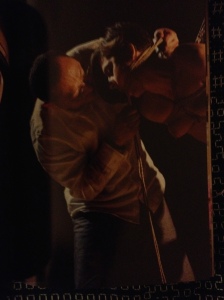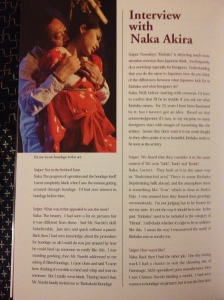Naka Akira: 緊縛写真集 (Rope Artworks) (2014)
This is a rich book. For a change, the photos of Naka’s rope work is not by Sugiura Norio (the only one except Nureki Chimuo that Naka calls ”sensei”), but by Erisa Sato. She has stated that she is interested in a ”relational” aspect of kinbaku – this is perhaps one of the reasons that the book contains quite a few images where not only the tied person is shown, but also the person tying. The bakushi emerges from the shadows… As friends of this blog might have noticed, whenever I have the chance I tend to choose such images wherever I can, but in the publications they are relatively rare.
In addition to the photos of sessions with a number of interesting models (including Gorgone and Iroha Shizuki), the book comes with a DVD. And to top that off, it also has an interview with Naka-san translated into quite readable English, with statements like the following: ”They say that a binding person is sadistic and a bound person is masochistic. When I bind someone however, I put myself into my partner’s position and care about their feeling. I have a feeling that I am not sadistic by nature. I think I am rather masochistic. In fact, I even think that is why I can do that way.”
Photo by Erisa Sato.
ISBN: 978-4-8130-7160-0
Publisher: Taiyo Tosho, 2014
PS For anyone who wants to read some other interviews with Naka San, there is a recent one in Spanish from his visit to Madrid here (including a short video):
http://www.elmundo.es/madrid/2014/11/15/54669d5bca4741ee698b457b.html
Also, there is a somewhat longer interview in Su Zume’s new book Pink Kinky: Japan’s Sex Underground (Kingyo, 2014, p. 109–119) – that also has smaller interviews with Kinoko (not quite up-to-date), Hiromi Saotome, and many others. Admittedly somewhat superficial, but gives a nice sneek peek into the night life of Tokyo.




















